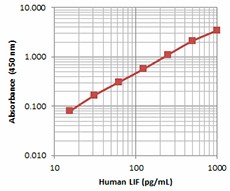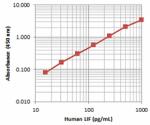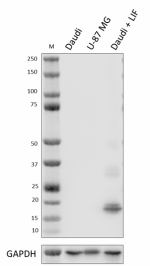- Clone
- Poly5233 (See other available formats)
- Regulatory Status
- RUO
- Other Names
- Leukemia Inhibitory Factor, HILDA (human interleukin in DA cells), MLPLI (melanoma-derived LPL inhibitor), DIA (differentiation-inducing factor)
- Isotype
- Goat Polyclonal IgG

-

-

Whole cell extracts (15 µg total protein) from Daudi cells, U-87MG cells, and Daudi cells + recombinant human LIF protein (Cat. No. 593902) were resolved by 4-12% Bis-Tris gel electrophoresis, transferred to a PVDF membrane, and probed with 1.0 µg/mL purified anti-LIF (clone Poly5233) overnight at 4°C. Proteins were visualized by chemiluminescence detection using HRP donkey anti-goat. Direct-Blot™ HRP anti-GAPDH antibody (Cat. No. 607904) was used as a loading control at a 1:50000 dilution (lower). Lane M: Molecular weight marker
| Cat # | Size | Price | Quantity Check Availability | ||
|---|---|---|---|---|---|
| 523301 | 100 µg | $350.00 | |||
Human LIF stands for Leukemia Inhibitory Factor. It belongs to the IL-6 family of cytokines, and is a variably glycosylated, secreted protein with a mass of 38 – 67 kD. The mature form has 180 amino acids and contains six conserved cysteines, which form three intramolecular disulfide bonds. The protein itself forms a four-helix bundle fold. Human LIF shares 78% amino acid identity with mouse LIF.
LIF is a pleiotropic cytokine involved in cellular development, inflammation, immunology, and neoplasia. It often has contradictory effects within different contexts, either stimulating cell proliferation, or inducing differentiation of mouse M1 leukemic myeloid cell line into macrophages. With cultured embryonic stem cells, LIF has been an important laboratory tool to help maintain stem cell pluripotency for cell cultures. It is involved in the mechanisms of embryonic implantation, inflammatory disorders such as arthritis, immunomodulation, carcinogenesis, and neoplasia-associated cachexia.
LIF binds to both LIF Rα and gp130 on the cell surface to form a heterotrimeric complex, which initiates cell signaling through the JAK-STAT pathway. LIF can also activate the MAPK, PI3K, and p53 signaling pathways. Soluble forms of both binding partners do exist in circulation and potentially serve to further regulate LIF action.
Product Details
- Verified Reactivity
- Human
- Antibody Type
- Polyclonal
- Host Species
- Goat
- Immunogen
- Human LIF, amino acids (Ser23-Phe202) (Accession# NP_002300.1), was expressed in E. coli.
- Formulation
- Phosphate-buffered solution, pH 7.2, containing 0.09% sodium azide.
- Preparation
- The antibody was purified by affinity chromatography.
- Concentration
- 0.5 mg/ml
- Storage & Handling
- The antibody solution should be stored undiluted between 2°C and 8°C.
- Application
-
ELISA Capture - Quality tested
WB - Verified - Recommended Usage
-
Each lot of this antibody is quality control tested by ELISA assay. A concentration of 0.5 µg/ml of the capture antibody was utilized to generate the example standard curve for human LIF. For western blotting, the suggested use of this reagent is 0.1 - 1.0 µg/mL. It is recommended that the reagent be titrated for optimal performance for each application.
- Application Notes
-
ELISA Capture: To measure human LIF, this antibody can be used as a capture antibody in a sandwich ELISA format and paired with the biotinylated clone M017C3 antibody as the detection antibody. Recombinant Human LIF (ELISA Std.) can be used as the protein standard.
Note: For testing human LIF in serum, plasma, or supernatant, BioLegend’s LEGEND MAX™ Human LIF ELISA Kit is specially developed and recommended. - RRID
-
AB_2562322 (BioLegend Cat. No. 523301)
Antigen Details
- Structure
- Four-helix bundle fold.
- Distribution
-
Expressed in the trophectoderm of the developing embryo and activated CD4+ T cells.
- Function
- LIF is a pleiotropic cytokine involved in cellular development, inflammation, immunology, and neoplasia.
- Interaction
- Embryonic stem cells.
- Ligand/Receptor
- LIF Rα, gp130
- Cell Type
- T cells
- Biology Area
- Cell Biology, Immunology, Stem Cells
- Molecular Family
- Cytokines/Chemokines, Growth Factors
- Antigen References
-
1. Metcalf D. 1991. Int. J. Cell Cloning 2:95-108.
2. Zhang JG, et al. 1998. J. Biol. Chem. 17:10798.
3. Kamohara H, et al. 2007. Int. J. Oncol. 4:977.
4. Marshall MK, et al. 1994. Endocrinology 135:141.
5. Vogiagis D, Salamonsen LA. 1999. J. Endocrinol. 160:181.
6. Zouein FA, et al. 2013. Eur. Cytokine Netw. 24:11.
7. Mathieu ME, et al. 2012. Stem Cell Rev. 8:1.
8. Hu W, et al. 2007. Nature 450:721.
9. Trouillas M, et al. 2009. Eur. Cytokine Netw. 20:51.
10. Metcalfe SM. 2011. Genes Immun. 3:157. - Gene ID
- 3976 View all products for this Gene ID
- UniProt
- View information about LIF on UniProt.org
Other Formats
View All LIF Reagents Request Custom Conjugation| Description | Clone | Applications |
|---|---|---|
| Purified anti-human LIF | Poly5233 | ELISA Capture,WB |
| LEAF™ Purified anti-human LIF | Poly5233 | Neut |
Compare Data Across All Formats
This data display is provided for general comparisons between formats.
Your actual data may vary due to variations in samples, target cells, instruments and their settings, staining conditions, and other factors.
If you need assistance with selecting the best format contact our expert technical support team.
-
Purified anti-human LIF


Whole cell extracts (15 µg total protein) from Daudi cells, ... -
LEAF™ Purified anti-human LIF

Recombinant human LIF (Cat. No. 593904) (black circles) indu...
